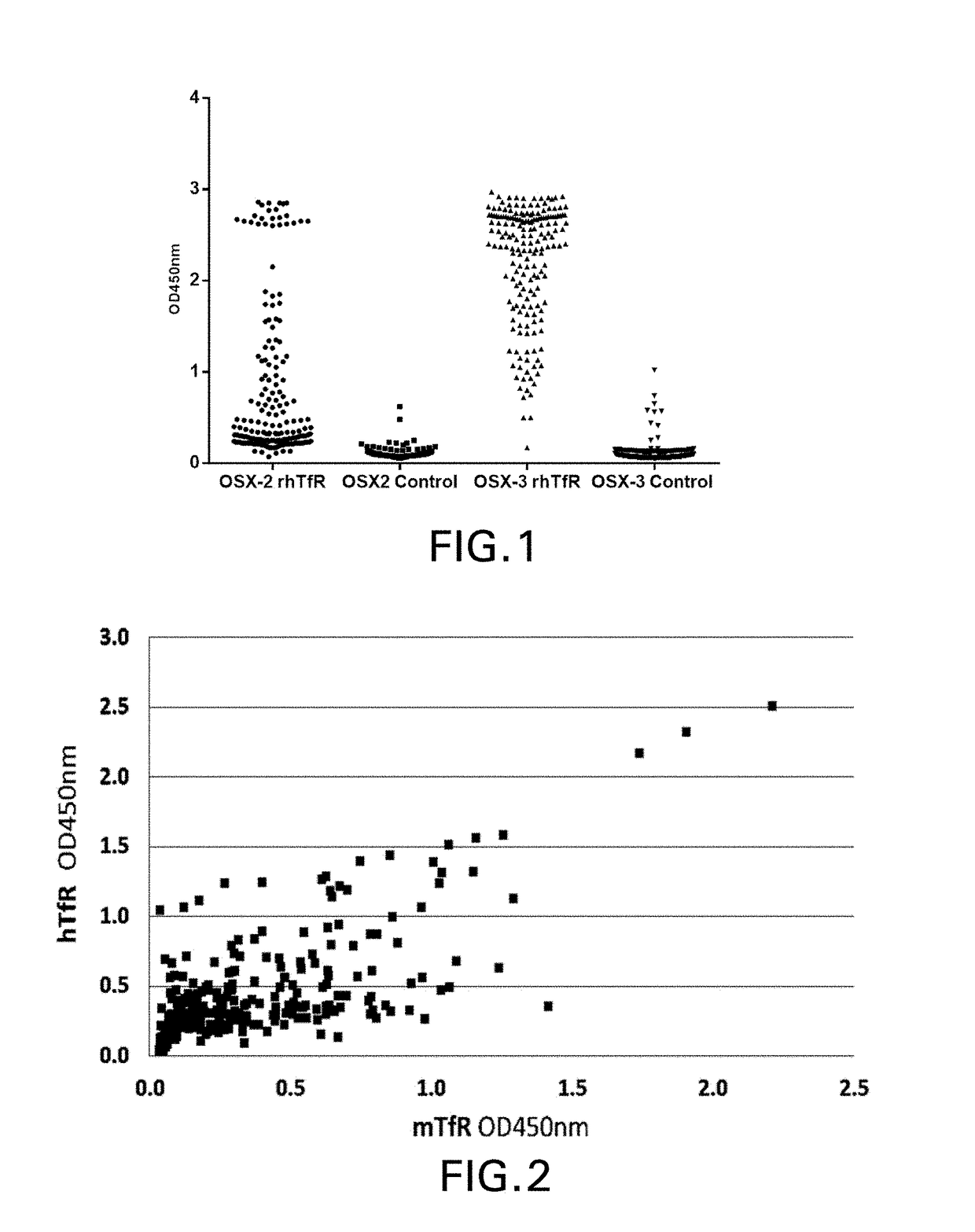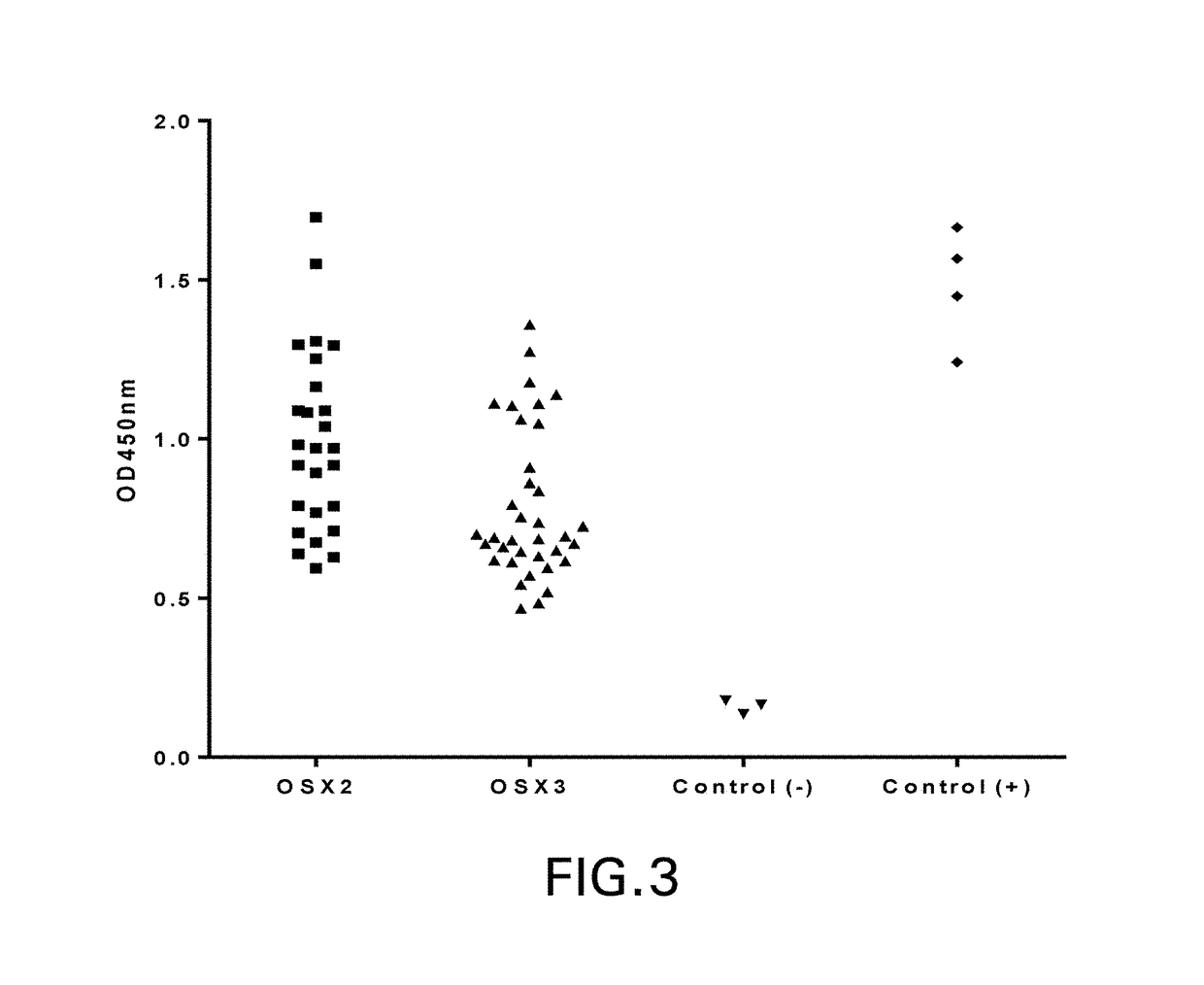TfR SELECTIVE BINDING COMPOUNDS AND RELATED METHODS
- Summary
- Abstract
- Description
- Claims
- Application Information
AI Technical Summary
Benefits of technology
Problems solved by technology
Method used
Image
Examples
example 1
ethods
[0228]A1. Phage Display Selection of VNARs Having TfR-Binding Properties
[0229]The phagemid vector used for both phage display and monomeric VNAR expression is pOsD2, a modified version of pSEX81 (Progen) in which a 6×His tag (SEQ ID NO: 483), a FLAG tag, and an amber stop codon were inserted between the VNAR (inserted into SfiI sites) and the full-length PIII protein of the M13 phage (the PCT '166 appln.).
[0230]Three different semi-synthetic VNAR libraries were panned including a wobbegong shark library OSX-2 (complexity˜6.8×109 CFU) constructed as previously described (Nuttall et al., Mol Immunol. 2001 August; 38(4):313-26) and the OSX-3 and OSX-4 synthetic libraries (described in the PCT '166 appln.). The phagemid vector used for both phage display and monomeric VNAR expression is pOsD2, a modified version of pSEX81 (Progen) in which a 6×His tag (SEQ ID NO: 483), a FLAG tag, and an amber stop codon were inserted between the VNAR (inserted into SfiI sites) and the full-length...
example 2
l Selections for TfR-1-Binding VNARs
[0251]Libraries were also selected for pH-sensitivity by binding the phage to plates coated with human Tf-1, washing at pH 7.2 and eluting the bound phage with buffer at pH 5.2 for 2-3 rounds of panning.
[0252]Additionally, 2-3 rounds of panning were performed by internalization using TfR-1 expressing cell lines as previously described with minor modifications (Poul et al., J Mol Biol. 2000 Sep. 1; 301(5):1149-61). Libraries were enriched by a single round of solid-phase panning on rhTfR-1 prior to cell-based selections. A negative selection was carried out for 60 min. at 4° C. using adherent MX-1 human breast cancer cells (Cell Lines Service GmbH) prior to adding the deplete library to either mouse bEnd.3 (ATCC, CRL-2299) or human SKOV 3 cells (ATCC, HTB-77). To recover phage from within the cell, surface-bound phages were removed with low pH glycine and trypsin before lysing the cells in 100 mM triethylamine. Recovered phages were rapidly neutral...
example 3
Analysis of TfR-1-Binding VNARs
[0254]VNAR inserts were sequenced by the dye termination method with an automated sequencer (Applied Biosystems) their corresponding amino acid aligned using Clustal W 2.0 and Clustal X 2.0 programs (Larkin et al., Bioinformatics 2007 Nov. 1; 23(21):2947-8). Framework and CDR regions were identified by reference to known VNAR structures and unique and related clones were identified by amino acid sequence of the CDR3 and CDR1 regions.
PUM
| Property | Measurement | Unit |
|---|---|---|
| Fraction | aaaaa | aaaaa |
| Electric charge | aaaaa | aaaaa |
| Electric charge | aaaaa | aaaaa |
Abstract
Description
Claims
Application Information
 Login to View More
Login to View More - R&D
- Intellectual Property
- Life Sciences
- Materials
- Tech Scout
- Unparalleled Data Quality
- Higher Quality Content
- 60% Fewer Hallucinations
Browse by: Latest US Patents, China's latest patents, Technical Efficacy Thesaurus, Application Domain, Technology Topic, Popular Technical Reports.
© 2025 PatSnap. All rights reserved.Legal|Privacy policy|Modern Slavery Act Transparency Statement|Sitemap|About US| Contact US: help@patsnap.com



